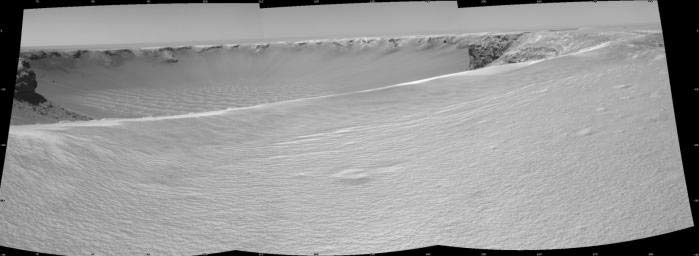Mars Rover Sends First Photo of Victoria Crater

NASA's Opportunity Mars rover returned its first photos of Victoria Crater at Meridiani Planum.
The robot has started to relay tantalizing glimpses of the huge impact crater after a lengthy day-by-day grind across the martian landscape that ended up being a 20-month journey to reach the destination.
Initial images show rugged walls with layers of exposed rock. The floor is shown to be blanketed with dunes, as researchers already knew. The far wall is about a half-mile away.
"This is a geologist's dream come true," said Steve Squyres of Cornell University, principal investigator for NASA's twin rovers Opportunity and Spirit. "Those layers of rock, if we can get to them, will tell us new stories about the environmental conditions long ago. We especially want to learn whether the wet era that we found recorded in the rocks closer to the landing site extended farther back in time. The way to find that out is to go deeper, and Victoria may let us do that."
Memory lane
Reaching the crater promises to be a trip down memory lane, a look into Mars' history, said David Des Marais, an astrobiologist at NASA's Ames Research Center at Moffett Field, California in an interview prior to the milestone announced today. By scanning and studying the exposed bedrock within the crater, he said, scientists gain a view into the planet's past.
The plan for studying the 2,625-foot-wide (800 meters) crater is to first map out the terrain that's inside the feature, including the large dune field at the bottom of Victoria.
Breaking space news, the latest updates on rocket launches, skywatching events and more!
In an earlier interview with SPACE.com, Squyres detailed what's next: After reaching the rim of Victoria at what's been dubbed Duck Bay, there are good views from there of Cape Verde, Cabo Frio, and much of the crater interior.
From that spot, Squyres added, the rover will use its set of navigation cameras, as well as acquire portions of the landscape with its Panoramic Camera, as well as utilize to some degree its Mini-Thermal Emission Spectrometer, or Mini-TES. This instrument sees infrared radiation emitted by objects.
Go inside?
With close-up imagery in hand, ground controllers and scientists will begin to piece together a strategy to intensively study Victoria Crater.
According to NASA's Des Marais there remains the prospect of driving into the large crater. But getting out could be tricky, he said.
Opportunity and its twin, the Spirit Mars rover, have been exploring Mars since January 2004. The Mars Exploration Rover mission is part of NASA's Mars Exploration Program, a long-term effort of robotic exploration of the red planet.
- Video: All Eyes on Mars
- Images: Visualizations of Mars
- Mars Probes Continue to Unlock Planet's Mysteries
- Complete Coverage: Mars Rovers
- All About Mars

Leonard David is an award-winning space journalist who has been reporting on space activities for more than 50 years. Currently writing as Space.com's Space Insider Columnist among his other projects, Leonard has authored numerous books on space exploration, Mars missions and more, with his latest being "Moon Rush: The New Space Race" published in 2019 by National Geographic. He also wrote "Mars: Our Future on the Red Planet" released in 2016 by National Geographic. Leonard has served as a correspondent for SpaceNews, Scientific American and Aerospace America for the AIAA. He has received many awards, including the first Ordway Award for Sustained Excellence in Spaceflight History in 2015 at the AAS Wernher von Braun Memorial Symposium. You can find out Leonard's latest project at his website and on Twitter.
